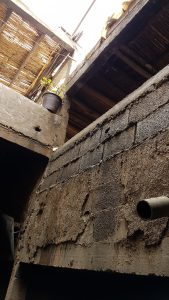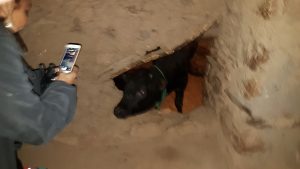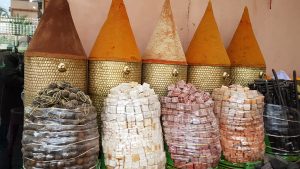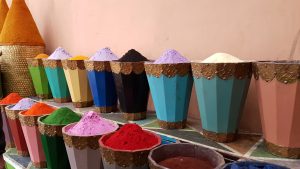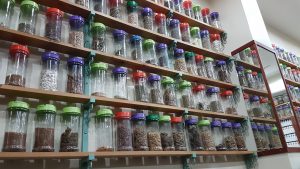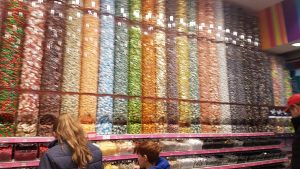Sunday 20th November
We started the day with a camel ride in the desert of Pushkar. Some people climbed onto the camel’s back, but I wasn’t so brave – I sat in the cart. I was sitting near the camel’s rear. That wasn’t so fortunate for me. The camel did its business, quite neatly might I say, but that wasn’t the surprise. All of a sudden the camel’s tail rose and whoosh, a gush of air greeted me. Despite that, I got the giggles and that together with the a bumpy ride added to the experience.
We alighted from the camel ride, and had a chance to browse and stroll along the bazaar. Wow! As I love markets, this experience was just for me. Unfortunately, we didn’t have much time here as we needed to continue on our journey.
We left Pushkar and drove to Jaipur – the Pink City. It’s known as the Pink City because the buildings are built with pink-coloured sandstone. Jaipur is named after Maharaja Jai Singh II (more about him tomorrow). The roads in Jaipur were wider than what I had seen up until now.
We took a rickshaw ride through Jaipur through the narrow dusty streets (actually everywhere we have been has been dusty). In the evening we went to see a Bollywood film at Raj Mandir, a very famous and impressive cinema – impressive as the architecture inside is so beautiful, nicer than any theatre I have visited. The film was a Bollywood action film. I found it comical as we saw uber-Bond type stunts, the dialogue was interspersed with English words and the occasional English sentence. It was a theatre experience as the Hindi audience would cheer out loud at various points during the film. An unforgettable experience.
Monday 21st November
An early start again as we went to the Amber Fort. It is such a pity that I cannot upload images onto this blog (possibly some glitch between WordPress and the server!?!?). The Fort is high on a hill. How did we get there? On elephants!!!
Not only the experience of the elephant ride, but the view was unbelievable. Hawkers wouldn’t leave us alone. All along the journey up to the Fort they tried to sell their wares.
The Fort. So much history – as well as at the City Palace and Museum which we visited during the afternoon. The architecture here was both Rajasthani and Mughal, Indo-Islamic.
Especially interesting for me was the stone observatory built by Maharaja Jai Singh II. This Maharaja must have been an amazing person as not only was he an architect and town planner but also an astronomer. The “tools” that he built at this observatory are unbelievable. They can tell the time of day to within 20 seconds. I had to buy a book about this as is found it fascinating. Sam will enjoy it too as there were so many mathematical equations involved in working out the various results.
On our way back from the Fort, we stopped at a gem and jewellery centre where we saw people cutting and polishing the gems.
There was an opportunity after this to go to a block printing factory, but everyone was too tired for this. Another opportunity was to go to the bazaar but I gave this a miss and went back to the hotel, only to find that there was a mall across the road. Well, that was an experience in itself! How does one cross a busy road in Jaipur at rush hour? Luckily a policeman was directing the traffic and he stopped the traffic for us to cross. Without him it would have been almost impossible to cross the road.
Tuesday 22nd
Again an early start, but this is the norm now.
We drove from Rajasthan to Uttar Pradesh. This is the most populated state in India. We drove through the mountains via a tunnel, but the tunnel didn’t look real – it looked more like paper mache.
We stopped at a village, Abhaneri, where we saw an amazing stepwell – a Boali. I had never seen a stepwell before, but it was enormous. These wells were used as hiding places many years ago when the Muslims attacked the Hindu kingdom. They destroyed the temples and broke the statues of the gods.
Along the way we saw cow dung cakes. These are used as fuel and I believe that they do not smell.
As I wrote earlier, the Indians use the car horn a lot. I have noticed that it is used to warn other drivers that you are there, as there is no rule to overtake on the outside so people overtake on both sides, weaving in and out of the traffic. The horns have various sounds, so one could compose a song.
Some trucks have a sign “horn please” emblazoned across the back. They say here that by honking the horn is to express one’s existence and to share the joy with everyone around you. Our driver must be very happy!!!!
We continued to one of the most beautiful architectural masterpieces on earth – the Taj Mahal. This mausoleum was built by Emperor Shah Jahan in memory of his wife who died in childbirth and it took 23 years to complete. Walking to the Taj you walk through various arches. All of a sudden you are greeted by this majestic, beautiful, peaceful sight. Getting closer to it one can see and admire the white marble building embedded with gems. We stayed until sunset in the hope that we would see the colour changes, but unfortunately the sunset this day was not the clearest. We were lucky we didn’t visit it at sunrise on Wednesday, which was the original plan, because as we looked at the Taj Mahal from the Agra Fort (which I shall write about in the next blog) it was quite misty.
